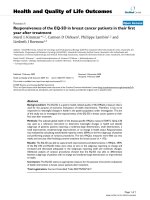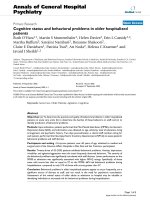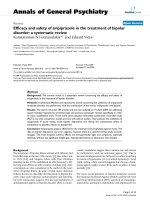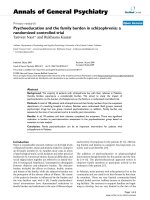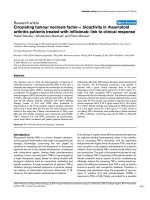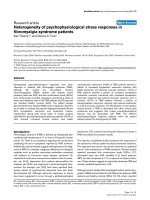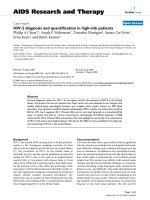Báo cáo y học: " ESPECTRA: Searching the Bipolar Spectrum in Eating Disorder patients" pps
Bạn đang xem bản rút gọn của tài liệu. Xem và tải ngay bản đầy đủ của tài liệu tại đây (185.84 KB, 5 trang )
STUD Y PRO T O C O L Open Access
ESPECTRA: Searching the Bipolar Spectrum in
Eating Disorder patients
Rodolfo N Campos
1*
, Jules Angst
2
, Taki A Cordas
3
and Ricardo A Moreno
4
Abstract
Background: Bipolar Disorder (BD) is a chronic, recurrent and highly prevalent illness. Despite the need for correct
diagnosis to allow proper treatment, studies have shown that reaching a diagnosis can take up to ten years due to
the lack of recognition of the broader presentations of BD. Frequent comorbidities with other psychiatric disorders
are a major cause of misdiagnosis and warrant thorough evaluation.
Methods/Design: ESPECTRA (Occurrence of Bipolar Spectrum Diso rders in Eating Disorder Patients) is a single-site
cross-sectional study involving a comparison group, designed to evaluate the prevalence of bipolar spectrum in an
eating disorder sample. Women aged 18-45 years will be evaluated using the SCID-P and Zurich criteria for
diagnosis and the HAM-D, YOUNG, SCI-MOODS, HCL-32, BIS-11, BSQ, WHOQoL and EAS instruments for rating
symptoms and measuring clinical corre lates.
Discussion: The classificatory systems in psychiatry are based on categorical models that have been criticized for
simplifying the diagnosis and leading to an increase in comorbidities. Some dimensional approaches have been
proposed aimed at improving the validity and reliability of psychiatric disorder assessments, especially in conditions
with high rates of comorbidity such as BD and Eating Disorder (ED). The Bipolar Spectrum (BS) remains under-
recognized in clinical practice and its definition is not well established in current diagnostic guidelines. Broader
evaluation of psychiatric disorders combining categorical and dimensional views could contribute to a more
realistic understanding of comorbidities and help toward establishing a prognosis.
Background
Bipolar disorder (BD) is a chronic and disabling condi-
tion associated with im pairment of quality of life and
occupational functioning. Diagnosing BD is a challenge
due to its phenomenological complexity, variable course
and correlates. The current classificatory systems (ICD-
10 and DSM-IV) define diagnostic guidelines that have
been subject to criticism for failing to represent clinical
reality. As a result, reports based on these systems pro-
duc e data that cannot be generalized for the population
as a whole. The Bipolar Spectrum (BS) model suggests
that presentations not officially recognized are part of a
continuum and that different dimensions may be part of
a single entity, e.g. BD/Unipolar Depression; BD/Schizo-
phrenia; BD/Personality Disorder (Borderline) [1].
Although descriptions of BD’s classic presentations are
consiste nt in the literature, the expansion of the borders
of the condition remains controversial [2]. The use of
broader definitions results in a direct increase in the
prevalence of the disorder. A review of the ECA study
database (Epidemiological Catchment Area) showed that
6.4% of the general population met criteria for BS [3],
while the original study reported a BD prevalence of
0.8%. Other researchers have found a prevalence ranging
from 2.4 to 8.3% for the expanded forms of BS [4,5].
Although recent studies have shown that lifetime pre-
valence rates are higher than previously thought, BD
remains under-recognized in routine clini cal practice. A
survey noted that 69% of patients with bipo lar disorder
reported an initial misdiagnosis, with more than one
third experiencing a delay of 10 years or greater before
receiving a definitive diagnosis of bipolar disorder [ 6].
Under-recognition of bipolar disorder has dramatic clin-
ical consequences such as increased suicide risk, higher
rates of substance use, iatrogenic worsening of long
* Correspondence:
1
Researcher of the Mood Disorders Unit (GRUDA). Department and Institute
of Psychiatry, Clinicas Hospital, University of Sao Paulo, School of Medicine,
Sao Paulo, Brazil
Full list of author information is available at the end of the article
Campos et al . BMC Psychiatry 2011, 11:59
/>© 2011 Campos et al; licensee BioMed Central Ltd. This is an Open Access article distributed under the terms of the Creative Commons
Attribution License ( which permits unrestricted use, distribution, and re production in
any medium, provid ed the original work is properly cited.
term course of the illness (due to antidepressant use)
and higher economic costs [7]. Matza et al showed that
the misdiagnosis of BD results in higher overall annual
treatment costs due to inpatient, outpatient and drug
expenses [8].
Comorbidity is the norm rather than the e xception in
BD and this is a major cause of misdiagnosis. Condi-
tions that manifest simultaneously with BD tend to
complicate the course and evolution through early
onset, more severe episodes, acceleration of the cycles
and suicidal behavior [9]. McElroy et al found that 65%
of all patients with BD presented at least one
lifetime comorbidity, 47% at least two and 24% at least
3 [10].
Eating Disorders (ED) are severe conditions often
associated with other psychiatric disorders, in which the
prevalence of at least one mood disorder can be up to
96% [11]. The enormous variation in the prevalence of
comorbidities in this population partl y reflects the dif-
ferent diagnostic criteria and instruments applied,
although the strong relationship of these disorders i s
clear. A positive association between mood disorders
and obesity has also been reported, and a recent study
showed a high prevalence of BS in severely obese
patients seeking surgical treatment [12].
Patterns of psychiatric comorbidity represent a possi-
ble strategy for improving recognition of bipolar disor-
der in patients presenting with depressive symptoms
who may benefit from additional screening for bipolar
disorder [8].
Methods/Design
ESPECTRA Project
ESPECTRA ( OCCURRENCE OF BIPOLAR SPECTRUM
DISORDERS IN EATING DISORDER PATIENTS)isa
cross-sectional study designed to evaluate the prevalence
of bipolar spectrum in an eating disorder sample.
The aim of the study is to examine a sample (ED)
with a high prevalence of comorbidities, combining cate-
gorical and dimensional diagnostic perspectives, and
their clinical correlates such as impulsivity, body image
and quality of life. Evaluating clinical aspects beyond the
phenomenological diagnosis should improve the detec-
tion of hidden bipolarity, determine degree of severity,
and its consequences in multiple dimensions.
Design of ESPECTRA
The ESPECTRA study has a cross-sectional design
involving a comparison group, and is to be conducted at
a single site.
Subjects
Group 1: Inpatients or outpatients recruited from the
Eating Disorder Unit of the Institute of Psychiatry of
the Clinicas Hospital of the University of São Paulo,
School of Medicine, are to take part in the study.
Patients aged 18 to 45 years, clinically diagnosed with
Anorexia Nervosa, Bulimia Nervosa or Eating Disorder
Not Otherwise Specified will be selected for interview.
The diagnosis shall be re-evaluated according to the
DSM-IV-TR, and Binge-Eating Disorder patients will
be excluded. Absence of other comorbidities is an
exclusion c riterion.
Group 2: The control group shall consist of outpati-
ents recruited from the general gynecology clinic of the
Clinicas Hospital of the University of São Paulo, School
of Medicine. Based on medical records, women aged 18
to 45 years will be invited for interview. Those without
Bipolar Disorder and with an Eating Disorde r according
to the DSM-IV-TR are eligible to participate in the
study. Women with modified diagnosis of Premenstrual
Dysphoric Disorder [13] will be excluded.
The protocol was approved by the local Research
Ethics Committee, and conformed to the 2008 Helsinki
Declaration (Ethics Committee - CAPPesq - Comissão
de Ética para Análise de Projetos de Pesquisa do
HCFMUSP - protocol number: 1154/09).
Written Informed Consent shall be obtained from all
participants prior to any study-related activities.
Clinical Assessment
Standard data on demographics, general medical history,
previous psychiatric treatment and family history of psy-
chiatric disorders shall be collected. Specific information
on laxative and amphetamine use as well as use of
health resources and chronology of comorbidities are to
be evaluated. Patients will be interviewed using the
Structured Clinical Interview for DSM-IV Axis I Disor-
ders (SCID-I) [14].
A supplementary evaluation of the Bipolar Spectrum
(BS) will be carried out according to the Zurich criteria
[15], considering hypomanic episode duration of at least 1
day and no exclusion criteria, such as: hypomania induced
by antidepressant, substances (stimulants, alcohol, etc) and
other causes (corticosteroids, brain lesion).
a) Hypomanic Syndrome:
- Euphoria, irritability or overactivity;
- Have personally experienced problems or
received comments from others that something
must be wrong with them (consequences)
- Present at least three out of seven signs and
symptoms of DSM-IV hypomania
b) Hypomanic Symptoms:
- Episode of at least two hypomanic symptoms
without consequences
The Bipolar Spectrum is defined as:
1) BD I: Major Depressive Episodes associated with
mania;
Campos et al . BMC Psychiatry 2011, 11:59
/>Page 2 of 5
2) BD II: Major Depressive Episodes associated with
hypomanic syndrome (a) or hypomanic symptoms
(b);
3) BD minor:dysthymia,minordepressionorrecur-
rent brief depression associated with hypomanic syn-
drome (a) or hypomanic symptoms (b);
4) Pure Hypomania: hypomanicsyndrome(a)with-
out diagnosis of depression and hypomanic symp-
toms only.
• Depressive and manic symptomatological assess-
ment is to be conducted using the Hamilton Depres-
sion Rating Sc ale (HAM-D) [16] , the Young Mania
Rating Scale (YMRS) [17], the SCIMOODS [18,19]
and Hypomania Checklist (HCL-32) [20,21] for cur-
rent and lifetime symptoms.
• Quality of life and social adjustment: measured
with the WHOQoL [22] and Social Adjustment
Scale [23]. These instruments have previously been
translated and validated in Portuguese [24,25].
WHOQOL is a self-report 100-item scale comprising
6 domains: physical, psychological, independence
level, social, environment and spirituality. The Social
Adjustment Scale is a self report 54-question instru-
ment that measures instrumental and expressive role
performance over the past two weeks.
• Impulsivity: Barrat Impulsivene ss Scale (BIS-11)
[26] evaluates impulsiveness in three domains:
motor, lack of planning and attention. It is a 30-item
self-rated Likert scale and has a Portuguese version
[27].
• Bo dy Image: Body Shap e Questionnaire [28] evalu-
ates concerns with body shape and obsession and
self- depreciation due to the physical appearance.
There is also a Portugues e version o f the question-
naire available [29].
The participants shall be evaluated with the diagnos-
tic instruments and symptoms rating scales without
any kind of intervention.
All assessors had reliability training for applying the
instruments and the diagnostic assessment (SCID-I and
Bipolar Spectrum evalu ation) is to be applied to all par-
ticipants by the same investigator (RNC)
Primary outcomes
The main outcome is to determine the prevalence of
bipolar spectrum disorders in ED patient s of a tertiary-
care hospital.
Secondary outcomes
With the aim of determining clinical correlates useful in
diagnostic assessment, the following will be evaluated:
-Comorbidity profile;
- Quality of life and social adjustment;
- Impulsivity;
- Body image;
- Use of health services.
Planned Analyses
The sample will consist of patient groups with and with-
out comorbidity that have BS, and prevalence rates will
be estimated as the primary objective of the project.
Student’s t test shall be employed to compare patient
and control groups according to quality of life, social
adjustment, impulsivity, body image and use of health
resources for those variables presenting normality,
which will be analyzed using Kolgomorov-Smirnov’s
test. Non-normal variables shall be submitted to the
Mann-Whitney test. Qualitative variables of the groups
wllbecomparedbyPearson’ sChi-squaretestor
Fischer’s exact test.
Demographic and clinical information will be
expressed as mean and standard deviation for continu-
ous variables and as estimated frequencies for categori-
cal variables.
A significance level of 5% will be adopted for all tests.
Sample Size
To ensure a precise estimate of the prevalence of BS, a
95% level of confidence and a 5% level of precision will
be adopted. In order to calculate the sample size, an
estimate of prevalence will first be required. Due to the
large variation in prevalence of BD in the ED population
(0% to 63.6%), an intermediate value of 20% was elected.
Sample size (n) was calculated according to the follow-
ing formula [30]:
n =
Z
2
P(1 − P)
d
2
where:
n = sample size,
Z = Z statistic for level of confidence,
P = expected prevalence or proportion
d = precision
This yielded n = 62, with 95% level of confidence and
10% level of precision.
Discussion
The current classificatory systems in psychiatry use a
descriptive approach since the etiology of most disorders
remains unknown [31]. Despite the large number of stu-
dies on genetics and imaging techniques, phenomeno l-
ogy is still the core method of diagnosis. Robins and
Guze outlined that diagnostic validity could be improved
through precise clinical description, greater delineation
of the syndromes from other disorders, laboratory stu-
dies, follow-up studies of outcome, and family studies
[32]. A growing b ody of evidence has identified valida-
tors such as family history, demographic correlates,
course of illness and concurrent symptoms (beyond the
diagnostic criteria) [33] and a considera ble amount of
Campos et al . BMC Psychiatry 2011, 11:59
/>Page 3 of 5
research has been focused specifically on determining
whether mental disorders are best classified dimension-
ally or categorically.
The categorical model exhibits excessive diagnostic co-
occurrence and raises the question as to whether these
disorders really constitute distinct clinical entities.
Despites its ease of use, the model is unab le to effectively
describe the interacting biological vulnerabilities and dis-
positi ons, or environmental and psychosocial events in a
single diagnostic category [34]. It remains unclear if the
dimensional model can provide a more valid description
and classification of mental disorders. Core dimensions
must be identified, measured and validated. How, and to
what extent, these elements should be incorporated into
the diagnostic system must also be determined [35].
The definition of BS is controversial and g rounded in
a dimensional model whose boundaries are still unclear.
Although the proposed definitions differ on numerous
aspects, there is a general consensus that three different
presentations must underpin the BS definition [1]:
1- Hypomanic reactions to antidepressants
2- “Subthreshold” hypomania (below c urrent diag-
nostic cut-offs)
3- Non-manic marker s, such as: recurrent depres-
sion, family history of BD, early onset.
These different dimensions must be carefully assessed
in future studies so that the controve rsies can give way
to levels of evidence.
The ED patient group represents a high risk population
for other psychiatric disorders in particular mood disor-
ders. The prevalence of Major Depressive Disorder
(MDD) for instance, can reach 81% in Anorexi a Nervosa
(AN) and 63% in Bulimia Nervosa (BN) patients [36].
Bipolar symptoms are also common in the ED population
and McElroy et al reported that previous studies had
found a prevalence of BD in ED patients ranging from
2.3% to 63.6% [37]. This heterogeneity reflects the differ-
ent definitions of BD and instruments used to assess the
condition, in some instances representing the categorical
full criteria diagnosis and in others, subsyndromic cases.
Patients with both BD and ED tend to have a higher
number of lifetime depressive episodes and greater psy-
chiatric comorbidity, excluding eating and mood disor-
ders [38]. The high comorbidity of BD and ED has yet
to be fully explained. One hypothesis holds that they are
different disorders and each represents ri sk factors for
the other disorder, or even that they are similar final
states of different etiological conditions. Another possi-
bility is that the comorbid disorder is related through
shared pathophysiological mechanisms [37].
The evaluation of lifetime comorbidities according to
current classificatory schemes shows a high prevalence
of psychiatric disorders that are not always “true comor-
bidities”, highlighting the need to refine the conceptuali-
zation of mental disorders. Assessing comorbidity
according to the official operational, criteria, and com-
paring with the broader dimensional model, the effect of
these two approaches can be accurately estimated in a
given population.
In this study, the diagnosis is considered to go beyond
the classic symptoms, combining the categorical and
dimensional approaches and taking into account other
clinical correlates, in orde r to enhance both the reliabil-
ity and validity of diagnosis. Establishing severity criteria
based on less specific general parameters such as quality
of life and use of health resources will help identify how
the clinical profile is related to outcome.
BS is under-recognized in clinical practice [15] and
comorbidities can represent major confounding factors
delaying BS identification . The early onset of ED and its
overlap with mood symptoms are also key points to
consider in understanding the relationship of Mood Dis-
orders and ED.
More comprehensive a ssessment and measurement of
psychopathology can enhance operational diagnoses and
lead clinicians to broader examinations [39]. Broader eva-
luation of psychiatric disorders beyond pure phenomen-
ology and standardized categorical criteria can contribute
to a more realistic u nderstanding of comorbidities and
improve the possibility of establishing prognosis.
Acknowledgements
The authors would like to thank Prof Dr Doris Hupfeld Moreno
a
for her
critical comments and Domingos Junior Rodrigues dos Santos
a
, Rogeria
Oliveira Taragano
b
, Sabrina Campos
b
and Magda Costa
b
for acquisition of
data.
a- Mood Disorders Unit (GRUDA). Department and Institute of Psychiatry,
Clinicas Hospital, University of Sao Paulo, School of Medicine, Brazil.
b- Eating Disorders Unit (AMBULIM) - Department and Institute of Psychiatry,
Clinicas Hospital, University of Sao Paulo, School of Medicine, Brazil
Source of funding: support for this study was provided in the form of grants
from the Department & Institute of Psychiatry - University of São Paulo
School of Medicine.
RNC, JA, TAC and RAM report no other sources of funding.
Author details
1
Researcher of the Mood Disorders Unit (GRUDA). Department and Institute
of Psychiatry, Clinicas Hospital, University of Sao Paulo, School of Medicine,
Sao Paulo, Brazil.
2
Zurich University Psychiatric Hospital, Zurich, Switzerland.
3
Eating Disorders Unit (AMBULIM) - Department and Institute of Psychiatry,
Clinicas Hospital, University of Sao Paulo, School of Medicine, Sao Paulo,
Brazil.
4
Director of the Mood Disorders Unit (GRUDA). Department and
Institute of Psychiatry, Clinicas Hospital, University of Sao Paulo, School of
Medicine, Sao Paulo, Brazil.
Authors’ contributions
RAM made a substantial contribution to the conception and design of the
study and was involved in revising the manuscript for key intellectual
content.
RNC contributed to the study conception and design and provided clinical
assistance.
Campos et al . BMC Psychiatry 2011, 11:59
/>Page 4 of 5
TAC and JA contributed to the discussion on the methodology and the key
points involved in the background of the study.
Competing interests
RNC and TAC: Declare no competing interests.
RAM has acted as a consultant to, and conducted research sponsored by,
companies involved in the area of bipolar and depressive disorders (Servier,
Bristol Myers Squibb, Solvay Pharma, Abbott, Astra Zêneca, Pfizer, and
Roche).
JA has served on the advisory board for Eli Lilly & Company, Lundbeck, on
the speakers’ bureau for Eli Lilly & Company and AstraZeneca, and as a
consultant for Sanofi Aventis.
Received: 8 October 2010 Accepted: 14 April 2011
Published: 14 April 2011
References
1. Phelps J, Angst J, Katzow J, Sadler J: Validity and utility of bipolar
spectrum models. Bipolar Disord 2008, 10(1 Pt 2):179-93.
2. Campos RN, Campos JAO, Sanches M: A evolução histórica dos conceitos
de transtorno de humor e transtorno de personalidade: problemas no
diagnóstico diferencial. Rev Psiq Clín 2010, 37(4):162-6.
3. Judd LL, Akiskal HS: The prevalence and disability of bipolar spectrum
disorders in the US population: re-analysis of the ECA database taking
into account subthreshold cases. J Affect Disord 2003, 73:123-31.
4. Moreno DH, Andrade LH: The life-time prevalence, health services
utilization and risk of suicide of bipolar spectrum subjects, including
subthreshold categories in the São Paulo ECA study. J Affect Disord 2005,
87(2-3):231-41.
5. Merikangas KR, Akiskal HS, Angst J, Greenberg PE, Hirshfeld RM,
Petukhaova M, Kessler RC: Lifetime and 12-month prevalence of bipolar
spectrum disorder in the National Comobidity Survey replication. Arch
Gen Psychiatry 2007, 64(5):543-52.
6. Hirschfeld RM, Lewis L, Vornik LA: Perceptions and impact of bipolar
disorder: how far have we really come? Results of the national
depressive and manic-depressive association 2000 survey of individuals
with bipolar disorder. J Clin Psychiatry 2003, 64(2):161-74.
7. Dunner DL: Clinical consequences of under-recognized bipolar spectrum
disorder. Bipolar Disord 2003, 5(6):456-63.
8. Matza LS, Rajagopalan KS, Thompson CL, de Lissovoy G: Misdiagnosed
patients with bipolar disorder: comorbidities, treatment patterns, and
direct treatment costs. J Clin Psychiatry 2005, 66(11):1432-40.
9. Baldassano CF: Illness course, comorbidity, gender, and suicidality in
patients with bipolar disorder. J Clin Psychiatry 2006, 67(Suppl 11):8-11.
10. McElroy SL, Altshuler LL, Suppes T, Keck PE Jr, Frye MA, Denicoff KD,
Nolen WA, Kupka RW, Leverich GS, Rochussen JR, Rush AJ, Post RM: Axis I
psychiatric comorbidity and its relationship to historical illness variables
in 288 patients with bipolar disorder. Am J Psychiatry 2001, 158(3):420-6.
11. Godart NT, Perdereau F, Rein Z, Berthoz S, Wallier J, Jeammet P,
Flament MF: Comorbidity studies of eating disorders and mood
disorders. Critical review of the literature. J Affect Disord 2007, 97(1-
3):37-49, Epub 2006 Aug 22. Review.
12. Alciati A, D’Ambrosio A, Foschi D, Corsi F, Mellado C, Angst J: Bipolar
spectrum disorders in severely obese patients seeking surgical
treatment. J Affect Disord 2007, 101:131-138.
13. Halbreich U, Backstrom T, Eriksson E, O’brien S, Calil H, Ceskova E,
Dennerstein L, Douki S, Freeman E, Genazzani A, Heuser I, Kadri N, Rapkin A,
Steiner M, Wittchen HU, Yonkers K: Clinical diagnostic criteria for
premenstrual syndrome and guidelines for their quantification for
research studies. Gynecol Endocrinol 2007, 23(3):123-30.
14. First MB, Spitzer RL, Williams JBW, Gibbon M: Structured Clinical Interview
for DSM-IV (SCID). APA Press, Washington, DC, USA; 1997.
15. Angst J, Gamma A, Benazzi F, Ajdacic V, Eich D, Rössler W: Toward a re-
definition of subthreshold bipolarity: epidemiology and proposed
criteria for bipolar-II, minor bipolar disorders and hypomania. J Affect
Disord 2003, 73(1-2):133-46.
16. Hamilton M: A Rating scale for Depression. J Neurol Neurosurg Psychiatry
1960, 23:56-62.
17. Young RC, Biggs JT, Ziegler VE, Meyer DA: A Rating Scale for Mania:
Reliability, Validity and Sensitivy. Br J Psychiatry 1978, 133:429-35.
18. Dell’Osso L, Armani A, Rucci P, Frank E, Fagiolini A, Corretti G, Shear MK,
Grochocinski VJ, Maser JD, Endicott J, Cassano GB: Measuring mood
spectrum: comparison of interview (SCI-MOODS) and self-report
(MOODS-SR) instruments. Compr Psychiatry 2002, 43(1):69-73.
19. Ratzke R, Moreno DH, Gorestein C, Moreno RA: Validity and reliability of
the structured clinical interview for mood spectrum, Brazilian version
(SCIMOODS-VB). Rev Bras Psiquiatr .
20. Angst J, Adolfsson R, Benazzi F, Gamma A, Hantouche E, Meyer TD,
Skeppar P, Vieta E, Scott J: The HCL-32: Towards a self-assessment tool
for hypomanic symptoms in outpatients. J Affect Disord 2005, 88:217-233.
21. Soares OT, Moreno DH, Moura EC, Angst J, Moreno RA: Reliability and
validity of a Brazilian version of the Hypomania Checklist (HCL-32)
compared to Mood Disorder Questionnaire (MDQ). Rev Bras Psiquiatr
2010, 32(4):416-23.
22. The WHOQOL Group: What Quality of Life? World Health Forum. WHO:
Geneva; 1996, 354-56.
23. Weissman MM, Bothwell S: Assessment of social adjustment by patient
self-report. Arch Gen Psychiatry 1976, 33:1111-5.
24. Fleck MPA: O instrumento de avaliação de qualidade de vida da
Organização Mundial da Saúde (WHOQOL-100): características e
perspectivas. Ciênc. Saúde Coletiva 2000, 5(1):33-38.
25. Gorenstein C, Andrade L, Moreno RA, Bernik MA, Nicastri S, Cordás TA,
Camargo AP: Escala de auto-avaliação de adequação social: validação da
versão em língua portuguesa.Edited by: Gorenstein C, Andrade LHSG,
Zuardi AW. Escalas de avaliação clínica em psiquiatria e psicofarmacologia.
São Paulo: Lemos; 2000:401-414.
26. Patton JH, Stanford MS, Barratt ES: Factor structure of the Barratt
Impulsiveness Scale. J Clin Psychol 1995, 51:768-774.
27. von Diemen L, Szobot CM, Kessler F, Pechansky F: Adaptation and
construct validation of the Barratt Impulsiveness Scale (BIS 11) to
Brazilian Portuguese for use in adolescents. Rev Bras Psiquiatr 2007,
29(2):153-6.
28. Cooper PJ, Taylor MJ, Cooper Z, Fairburn CG: The Development and
Validation of the Body Shape Questionnaire. International Journal of
Eating Disorders 1987, 6:485.
29. Cordás TA, Castilho S: Imagem Corporal nos Transtornos Alimentares -
Instrumento de Avaliação: Body Shape Questionnaire. Psiquatria Biológica
1994, 2:17-21.
30. Naing L, Winn T, Rusli BN: Pratical Issues in Calculating the Sample Size
for Prevalence Studies. Archives of Orofacial Sciences 2006, 1:9-14.
31. Spitzer RL, First MB: Classification of psychiatric disorders. JAMA 2005,
294(15):1898-9.
32. First MB, Pincus HA, Levine JB, Williams JB, Ustun B, Peele R: Clinical utility
as a criterion for revising psychiatric diagnoses. Am J Psychiatry 2004,
161(6):946-54.
33. Kendler K: Toward a scientific psychiatric nosology: strengths and
limitations. Arch Gen Psychiatry 1990, 47:969-973.
34. Widiger TA, Samuel DB: Diagnostic categories or dimensions? A question
for the Diagnostic And Statistical Manual Of Mental Disorders–fifth
edition. J Abnorm Psychol 2005, 114(4):494-504.
35. Brown TA, Barlow DH: Dimensional versus categorical classification of
mental disorders in the fifth edition of the Diagnostic and Statistical
Manual of Mental Disorders and beyond: comment on the special
section. J Abnorm Psychol 2005, 114(4):551-6.
36. Herzog DB, Nussbaum KM, Marmor AK: Comorbidity and outcome in
eating disorders. Psychiatr Clin North Am 1996, 19(4):843-59.
37. McElroy SL, Kotwal R, Keck PE Jr, Akiskal HS: Comorbidity of bipolar and
eating disorders: distinct or related disorders with shared
dysregulations? J Affect Disord 2005, 86(2-3):107-27.
38. Wildes JE, Marcus MD, Fagiolini A: Eating disorders and illness burden in
patients with bipolar spectrum disorders. Compr Psychiatry 2007,
48(6):516-21.
39. Angst J: Psychiatric diagnoses: the weak component of modern research.
World Psychiatry 2007, 6(2):94-5.
Pre-publication history
The pre-publication history for this paper can be accessed here:
/>doi:10.1186/1471-244X-11-59
Cite this article as: Campos et al.: ESPECTRA: Searching the Bipolar
Spectrum in Eating Disorder patients. BMC Psychiatry 2011 11:59.
Campos et al . BMC Psychiatry 2011, 11:59
/>Page 5 of 5
